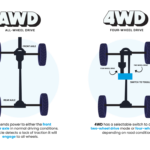
Beginner’s Guide: What Is a Drive Axle and What Does It Do?
Introduction
When it comes to understanding the various components of a vehicle, the drive axle is a crucial part that plays a significant role in the overall functionality of the vehicle. In this beginner’s guide, we will explore what a drive axle is and what it does.
What is a Drive Axle?
A drive axle, also known as a driving axle, is a component of a vehicle’s drivetrain system. It is responsible for transmitting power from the engine to the wheels, allowing the vehicle to move. In most cases, the drive axle is found in the rear of the vehicle, although there are some vehicles that have drive axles in the front as well.
Components of a Drive Axle
A typical drive axle consists of several key components:
- Axle Shafts: These are the shafts that connect the differential to the wheels. They transmit power from the differential to the wheels, allowing them to rotate and propel the vehicle forward.
- Differential: The differential is a gear mechanism that allows the drive wheels to rotate at different speeds while still receiving power from the engine. This is particularly important when the vehicle is turning, as the wheels on the outside of the turn need to rotate faster than the wheels on the inside.
- CV Joints: CV joints, or constant velocity joints, are flexible joints that allow the axle shafts to move up and down with the suspension while still transmitting power to the wheels. This is necessary to accommodate the movement of the suspension and ensure smooth power delivery.
- Bearings: Bearings are used to support the axle shafts and allow them to rotate freely. They help reduce friction and ensure that the wheels can rotate smoothly.
Functions of a Drive Axle
The drive axle performs several important functions in a vehicle:
- Power Transmission: The primary function of the drive axle is to transmit power from the engine to the wheels. This allows the wheels to rotate and propel the vehicle forward.
- Wheel Rotation: By transmitting power to the wheels, the drive axle enables them to rotate, allowing the vehicle to move in the desired direction.
- Speed Variation: The differential in the drive axle allows the drive wheels to rotate at different speeds, particularly when the vehicle is turning. This ensures smooth and controlled movement.
- Suspension Flexibility: The CV joints in the drive axle allow the axle shafts to move up and down with the suspension, accommodating the movement of the wheels and ensuring optimal power delivery.
- Support and Stability: The bearings in the drive axle support the axle shafts and provide stability, allowing them to rotate freely and reducing friction.
Signs of Drive Axle Problems
Like any other vehicle component, drive axles can experience issues over time. Some common signs of drive axle problems include:
- Clicking or popping noises when turning
- Vibrations or shuddering during acceleration
- Grease leakage around the axle shafts
- Difficulty in steering or maintaining control of the vehicle
If you notice any of these signs, it is important to have your vehicle inspected by a qualified mechanic to diagnose and resolve the issue.
Conclusion
A drive axle is a vital component of a vehicle’s drivetrain system, responsible for transmitting power from the engine to the wheels. Understanding its function and the various components involved can help you better maintain and diagnose any potential issues. If you suspect any problems with your drive axle, it is always recommended to consult a professional mechanic for proper inspection and repairs.




